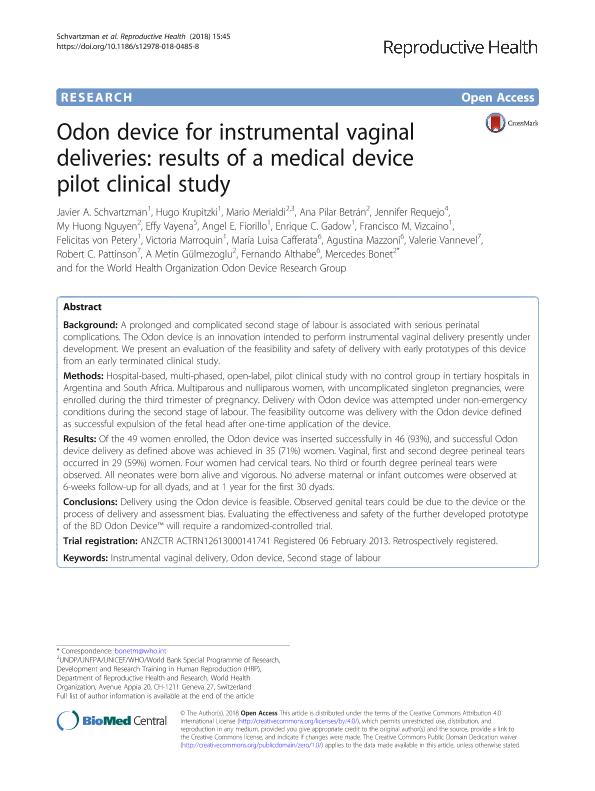Artículo
Odon device for instrumental vaginal deliveries: Results of a medical device pilot clinical study
Schvartzman, Javier Alfonso; Krupitzki, Hugo Bernardo ; Merialdi, Mario; Betrán, Ana Pilar; Requejo, Jennifer; Nguyen, My Huong; Vayena, Effy; Fiorillo, Angel Eduardo; Gadow, Enrique Curt
; Merialdi, Mario; Betrán, Ana Pilar; Requejo, Jennifer; Nguyen, My Huong; Vayena, Effy; Fiorillo, Angel Eduardo; Gadow, Enrique Curt ; Vizcaino, Francisco M.; Von Petery, Felicitas; Marroquin, Victoria; Cafferata, María Luisa; Mazzoni, Agustina; Vannevel, Valerie; Pattinson, Robert C.; Gülmezoglu, A. Metin; Althabe, Fernando
; Vizcaino, Francisco M.; Von Petery, Felicitas; Marroquin, Victoria; Cafferata, María Luisa; Mazzoni, Agustina; Vannevel, Valerie; Pattinson, Robert C.; Gülmezoglu, A. Metin; Althabe, Fernando ; Bonet, Mercedes
; Bonet, Mercedes
 ; Merialdi, Mario; Betrán, Ana Pilar; Requejo, Jennifer; Nguyen, My Huong; Vayena, Effy; Fiorillo, Angel Eduardo; Gadow, Enrique Curt
; Merialdi, Mario; Betrán, Ana Pilar; Requejo, Jennifer; Nguyen, My Huong; Vayena, Effy; Fiorillo, Angel Eduardo; Gadow, Enrique Curt ; Vizcaino, Francisco M.; Von Petery, Felicitas; Marroquin, Victoria; Cafferata, María Luisa; Mazzoni, Agustina; Vannevel, Valerie; Pattinson, Robert C.; Gülmezoglu, A. Metin; Althabe, Fernando
; Vizcaino, Francisco M.; Von Petery, Felicitas; Marroquin, Victoria; Cafferata, María Luisa; Mazzoni, Agustina; Vannevel, Valerie; Pattinson, Robert C.; Gülmezoglu, A. Metin; Althabe, Fernando ; Bonet, Mercedes
; Bonet, Mercedes
Fecha de publicación:
03/2018
Editorial:
BioMed Central
Revista:
Reproductive Health
ISSN:
1742-4755
Idioma:
Inglés
Tipo de recurso:
Artículo publicado
Clasificación temática:
Resumen
Background: A prolonged and complicated second stage of labour is associated with serious perinatal complications. The Odon device is an innovation intended to perform instrumental vaginal delivery presently under development. We present an evaluation of the feasibility and safety of delivery with early prototypes of this device from an early terminated clinical study. Methods: Hospital-based, multi-phased, open-label, pilot clinical study with no control group in tertiary hospitals in Argentina and South Africa. Multiparous and nulliparous women, with uncomplicated singleton pregnancies, were enrolled during the third trimester of pregnancy. Delivery with Odon device was attempted under non-emergency conditions during the second stage of labour. The feasibility outcome was delivery with the Odon device defined as successful expulsion of the fetal head after one-time application of the device. Results: Of the 49 women enrolled, the Odon device was inserted successfully in 46 (93%), and successful Odon device delivery as defined above was achieved in 35 (71%) women. Vaginal, first and second degree perineal tears occurred in 29 (59%) women. Four women had cervical tears. No third or fourth degree perineal tears were observed. All neonates were born alive and vigorous. No adverse maternal or infant outcomes were observed at 6-weeks follow-up for all dyads, and at 1 year for the first 30 dyads. Conclusions: Delivery using the Odon device is feasible. Observed genital tears could be due to the device or the process of delivery and assessment bias. Evaluating the effectiveness and safety of the further developed prototype of the BD Odon Device™ will require a randomized-controlled trial.
Palabras clave:
INSTRUMENTAL VAGINAL DELIVERY
,
ODON DEVICE
,
SECOND STAGE OF LABOUR
Archivos asociados
Licencia
Identificadores
Colecciones
Articulos(CEMIC-CONICET)
Articulos de CENTRO DE EDUCACION MEDICA E INVESTIGACIONES CLINICAS "NORBERTO QUIRNO"
Articulos de CENTRO DE EDUCACION MEDICA E INVESTIGACIONES CLINICAS "NORBERTO QUIRNO"
Articulos(CIESP)
Articulos de CENTRO DE INVESTIGACIONES EN EPIDEMIOLOGIA Y SALUD PUBLICA
Articulos de CENTRO DE INVESTIGACIONES EN EPIDEMIOLOGIA Y SALUD PUBLICA
Citación
Schvartzman, Javier Alfonso; Krupitzki, Hugo Bernardo; Merialdi, Mario; Betrán, Ana Pilar; Requejo, Jennifer; et al.; Odon device for instrumental vaginal deliveries: Results of a medical device pilot clinical study; BioMed Central; Reproductive Health; 15; 1; 3-2018; 1-10
Compartir
Altmétricas



